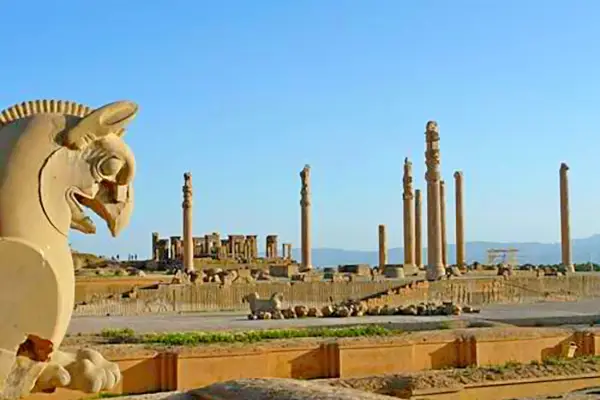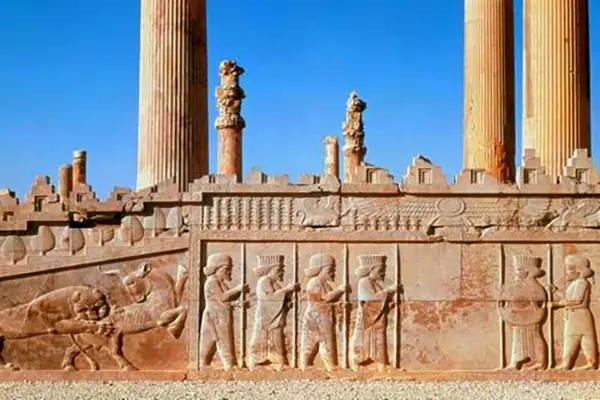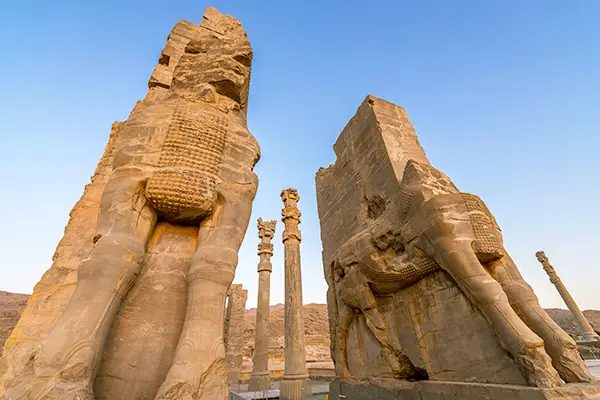
The city of Persepolis
- The names of Persepolis
- The creation of Persepolis and its significance for the Persian Empire
- The burning of Persepolis by Alexander the Great
- The discovery of Persepolis
- Persepolis in the 20th and 21st Centuries
- How to visit Persepolis
Persepolis is an ancient city located in Iran, 55 kilometers northeast of Shiraz. Its history began more than 2,500 years ago. Today, the surviving structures of Persepolis, including the palaces of Darius I and Artaxerxes III, the Tripylon Hall, the Hundred Column Hall, the foundations of the treasury, and residential quarters, are inscribed on the UNESCO World Heritage list.
From Parsa to Persepolis: Many names of the ancient Persian capital
This city has many names: Parsa, Takht-e Jamshid, Sadestun, and Chehel Menar. This Greek word (Περσέπολις) translates as "City of the Persians". Another name, Parsa, is evidenced in inscriptions at the entrance to a portico – a covered gallery with columns –attached to one of the buildings of the city. The historian Xenophon referred to the city as Persai in his writings. Later, Persepolis was also called Fars or Pars.
After archaeological excavations in Persepolis in the 1930s, the site began to be called Takht-e Jamshid (the Throne of Jamshid). People believed that the ruins of Persepolis were the remnants of a palace of the mythical Persian king Jamshid, built by divs (evil spirits). Takht-e Jamshid is the official name of this historic monument in today's Iran.

The creation of Persepolis and its significance for the Persian Empire
Persepolis is a complex that consists of several royal palaces. It was founded during the Achaemenid Empire – a state that unified the entire Middle East and Central Asia. The building of Persepolis began in 518 BCE under Darius I's reign. Upon ascending the throne, he decided to create a new capital in a fertile land sheltered by mountains that he favoured. However, the king did not live to see the city completed. The construction of the palaces continued under his successors for more than a century, with some buildings remaining unfinished.
The purpose of Persepolis and its importance to the Achaemenid Empire continue to be the subject of debates. One theory suggests that it was a ceremonial capital, built specifically for the celebration of Nowruz (the New Year festival according to the solar calendar), as well as for various receptions, parades, and religious ceremonies. This interpretation is based on inscriptions and bas-reliefs on the buildings of the city. For example, on a staircase leading to the Apadana Palace, a procession is depicted: representatives of 23 nations offering presents to the king in honour of the New Year. Additionally, there are reliefs depicting an army procession, the ascent to the throne, and a scene of a lion devouring a bull – a Zoroastrian symbol of the changing year.
Persepolis was not a political capital for sure. Its remote location near Mount Kuh-e Rahmat was unsuitable for governing the empire. Travel to Persepolis was nearly impossible during the rainy Persian winter season, when the paths turned to mud, so it could only be used in the spring and summer months. Ruling of the empire, however, took place from Susa, Babylon, or Ecbatana, depending on the time of year. There is also an opinion that Persepolis was intended to unite the empire’s diverse nations and religions. When getting to the city, visitors would see repeating reliefs that glorified the king's power and authority and promoted the equality of peoples.
The palaces were constructed on a vast monolithic platform. The builders arranged the structures in a way that allowed them to function as a sundial. Unfortunately, the palace complex of Persepolis suffered significant damage after it was set on fire. It contained numerous buildings: the Apadana Palace, the Hundred Columns Hall, the Darius and Xerxes' palaces, the treasury, Xerxes' harem, the council hall, and the Gate of All Nations. A two-kilometre water supply system was constructed under the city, and it remains intact to this day. On the hill near Persepolis, the rock-cut tombs of Artaxerxes II and III can still be found. It is also known that the city was surrounded by a triple wall with fortified towers.
The main materials used to build the palaces were grey limestone quarried from the mountains, along with sun dried and fired brick, clay, and cedar wood. Interestingly, the stone blocks were held together not by mortar but with metal clamps.

The burning of Persepolis by Alexander the Great
The Achaemenid Empire reached its peak during the reign of Darius I. By the time he ascended the throne, the empire – thanks to the conquests of his predecessors – stretched from Africa to India. However, numerous uprisings against central authority occurred within it. Darius managed to suppress separatist sentiments through reforms addressing administrative divisions and taxation, which temporarily stabilised the regions under his control.
After Darius I’s death, the power of the empire began to wane. All resources were directed towards the construction of the palace complexes, particularly Persepolis. The people rebelled due to the heavy burden of taxes. In an attempt to fill the treasury, the kings launched campaigns into new territories but encountered a formidable foe – the Greeks.
The Achaemenid Empire lasted for approximately 200 years and was eventually conquered by Alexander the Great during the reign of Darius III. At the Battle of Gaugamela (near the city of Erbil in Iraqi Kurdistan) in 331 BCE, Darius was defeated and fled the battlefield, hoping to gather a new army in the east. This opened the way for Alexander the Great into Asia. He conquered Babylon, Susa, and then Persepolis, the wealthiest cities of the time. Their treasuries overflowed with jewels, gold, and silver – the results of successful military campaigns and regular tributes. According to estimates, the treasury of Persepolis alone contained 3,600 tonnes of gold. The wealth of the Achaemenids was transported to Susa. According to the historical chronicles of the ancient Greek writer and philosopher Plutarch, that required 20,000 mules and 5,000 camels.
Before his departure in 330 BCE, Alexander the Great set Persepolis on fire. For many centuries, historians have tried to understand his reasonings. One of the most popular theories suggests that it was an act of revenge for Xerxes’ merciless burning of the Acropolis of Athens 150 years before these events. However, Iranian scholars dispute this. From their perspective, Alexander the Great saw that the Iranians had created a magnificent religious capital and realised that as long as it stood, hope for the revival of the Achaemenid Empire would remain in the hearts of the people. Their rituals and national consciousness would endure, and he would never be regarded as the rightful ruler. So he burned Persepolis to show that the empire had come to an end. It was the time to forget the Achaemenids, for Alexander the Great was now the sole ruler of Asia. Another theory exists as well. As an experienced and far-sighted military leader, Alexander the Great understood that Persepolis could become a rallying point for Iranians willing to resist. Whichever of these theories is correct, the burning of Persepolis did indeed mark the end of the Persian Empire.
However, Darius III was still alive. Alexander then began to pursue him, though he would not see Darius III alive. Darius was killed by members of his retinue when they found out that Alexander was approaching. Alexander showed respect for the fallen emperor. He sent Darius’ body to Persepolis and ordered a grand funeral, worthy of the former ruler of a mighty state. Yet, Darius’ burial site has never been found. Later, in Susa in 324 BCE, Alexander married Stateira, Darius’ daughter, thus became the rightful heir to the throne.
The Achaemenid Empire ultimately collapsed with Darius III's death. Persepolis remained the capital of Persia, which at that time became a province in Alexander the Great's empire, but it lost its former significance. Archaeologists have found various artefacts indicating that people continued to live in the city for some time, though the precise nature of what took place there remains unknown.

The discovery of Persepolis
Persepolis remained forgotten until European travellers and archaeologists stumbled upon it. They created the first descriptions and engravings of the city, dating from the 18th and 19th centuries. In the 1920s, under commission from the Iranian government, the German archaeologist and linguist Ernst Herzfeld prepared detailed documentation of the ruins, excavation plans, and proposed restorations. Full-scale excavations began only ten years later, led by Herzfeld himself with support from the University of Chicago and the Iranian government. Later, archaeologist Erich Schmidt took over the leadership. Over time, the city transformed. For instance, in the 1930s, archaeologists succeeded in fully restoring the building of Xerxes’ harem, which now houses an archaeological museum. Today, the excavations in Persepolis are almost complete, though restoration of the structures is ongoing.
The excavations revealed that Persepolis was not built by slaves. The rulers of the Achaemenid dynasty respected their workers, as evidenced by cuneiform inscriptions on Persepolis’s walls and clay tablets used to monitor construction. Workers received regular wages and insurance. Thus, in case of any accidents, the family of the injured person was supported by the empire. Interestingly, even women participated in the construction. They could work full or part-time and were paid on a par with men, while mothers received child allowances. According to art historian and Iranologist R.R. Vergazov, from the cuneiform inscriptions we know of modestly paid craftsmen (“kurtash”) hired as builders. Royal advisers oversaw the work teams in Persepolis. Alongside Persian craftsmen, Greek artisans were also involved in creating the city, as evidenced by certain tiles and small ornamental fragments found in Persepolis that resemble Argos and Corinthian motifs.
Persepolis in the 20th and 21st Centuries
Centuries later, the ruins of Persepolis once again witnessed a grand event. In 1971, Mohammad Reza Pahlavi, the Shahanshah (King of Kings) of Iran, held one of the most lavish and memorable ceremonies of the century at Persepolis.
The celebration took place at Persepolis and near the tomb of Cyrus the Great in Pasargadae from 12 to 14 October in 1971. The Shah declared it would be “the greatest celebration in the world”. He hired French architects, interior designers, and couturiers to design 50 tented apartments, known as the Golden City, near the ruins. Constructing this tent city took a year. The tents were draped with 39 kilometres of silk and arranged in five rows (symbolising the five continents) radiating out from a central fountain. The event included a costumed parade depicting 2,500 years of Persian history and a banquet for which 18 tonnes of food were brought from Paris.
The exact cost of the celebration remains unknown, with estimates ranging from $20 million to $500 million. This figure included not only the celebration itself but also the construction of the Shahyad Tower, or Tower of the Shahs’ Memory (renamed the Azadi, or Freedom Tower, after the revolution), in Tehran, as well as road construction to Persepolis and Pasargadae, development of infrastructure in the Hamadan province (where the first Achaemenid capital, Ecbatana, was once located), and the building of hotels in Tehran and Shiraz. Additionally, the Shiraz airport was renovated to accommodate international guests.
An entire forest was planted around the event site, and 50,000 birds were brought in from Europe to recreate how the now-deserted area might have looked during Achaemenid times – though, unfortunately, they perished within three days due to the high temperatures. All of this was prepared for the 600 esteemed guests, including royalty, presidents, and prime ministers from various countries. The Soviet Union was represented by the Chairman of the USSR Supreme Soviet, Nikolai Podgorny.
The Shah succeeded in staging a grand event, which was broadcast on television worldwide, captivating not only those present but also the viewing public. Through this event, the Shah sought to demonstrate that Iran was a modern country with a rich history. Few know that this event was preceded by an international programme of exhibitions and seminars on Persian history and culture, and thousands of schools were established throughout Iran thanks to the guests of the festival.
Through this celebration, Mohammad Reza Shah aimed to consolidate power and revive national identity among Iranians. However, it set apart the people and the Shah. They criticised the extravagance and labelled him a “Western puppet”. Eventually, public supported the Shah’s main opposition – the Shia clergy – leading to the 1979 overthrow of the monarchy and the establishment of the Islamic Republic.
Today, the Iranian government calls for the promotion of Islam, yet also encourages to remember the country’s pre-Islamic history and culture. Ask Iranians what they associate with their country, and the first things that come to mind are Persepolis and the powerful empire it represents. Today, Persepolis stands as a symbol of Iran, attracting thousands of tourists from around the world each year.
How to visit Persepolis
Persepolis can be reached from several cities:
- From Shiraz (60 km): you can get a taxi, with a travel time of approximately 1 hour
- From Isfahan (443 km): you can book a transfer, with a travel time of approximately 5 hours
- From Tehran (877 km):
- By plane, Tehran to Shiraz, travel time is approximately 2 hours
- By train, Tehran to Shiraz, travel time is approximately 15 hours
I want to visit
Persepolis (Takht-e Jamshid)
Visitor Information
- Opening Hours:
- Monday: 08:00 – 18:30
- Tuesday: 08:00 – 18:30
- Wednesday: 08:00 – 18:30
- Thursday: 08:00 – 18:30
- Friday: 08:00 – 18:30
- Saturday: 08:00 – 18:30
- Sunday: 08:00 – 18:30
- Entrance: Paid
- Cash/Credit Card accepted: Cash
- Region: Fars Province
- City: Shiraz
- Address: Shiraz-Marvdasht-Persepolis Square- Persepolis Complex
- Postal code: 7153744715
- Phone number: +987143341553
- Is open to public visitors: Yes
Tours featuring a visit to the Persepolis (Takht-e Jamshid)
- GUIDED GROUP TOUR

Guided group tour package
Tehran - Kashan - Abyaneh - Isfahan - Yazd - Persepolis - Shiraz
Tour start dates:
16.09.2025 -21.09.2025
05.10.2025 -12.10.2025
19.10.2025 -26.10.2025
02.11.2025 -09.11.2025
16.11.2025 -23.11.2025
30.11.2025 -07.12.2025
SGL € 1 310 per person
DBL € 1 140 per person
- GUIDED GROUP TOUR

Guided group tour pacakge
Tehran - Kashan - Abyaneh village - Isfahan - Yazd - Persepolis - Shiraz - Bandar Abbas - Keshm - Hormuz Island - Hengam Islands
Tour start dates:
16.09.2025 -27.09.2025
05.10.2025 -16.10.2025
19.10.2025 -30.10.2025
02.11.2025 -13.11.2025
16.11.2025 -27.11.2025
30.11.2025 -11.12.2025
SNG € 1 790 per person
DBL € 1 570 per person
- GUIDED PRIVATE TOUR

Private sightseeing tour to Iran
Tehran - Hamadan - Ali-Sadr - Behistun Inscription - Kermanshah - Taq-e Bostan - Shiraz - Persepolis - Yazd - Isfahan - Matinabad - Abyaneh - Kashan
Tour start dates:
ANY DATE
SGL € 5 400 per person
DBL € 3 300 per person












